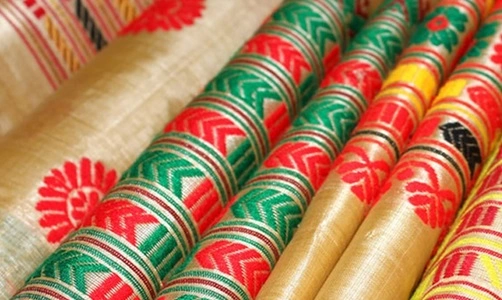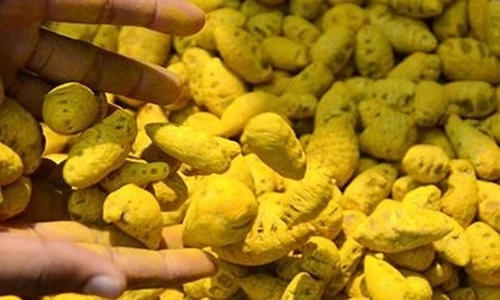India is the second-largest producer of silk in the world, contributing around 18% of global production. Known as the “Land of Silk”, India boasts diverse silk varieties that are produced across its different regions. The country’s unique climatic conditions and cultural traditions have nurtured a variety of silks, each with its own texture, luster, and utility. From the luxurious Mulberry silk to the rare Eri silk, India has been a hub of silk production for centuries.
In this article, we explore the top silk varieties in India, highlighting their origins, production areas, and unique characteristics.

1. Mulberry Silk
Mulberry silk is the most popular and widely produced silk in India, accounting for over 70% of the country’s total silk output. This variety comes from the silkworm Bombyx mori, which feeds exclusively on mulberry leaves. Mulberry silk is known for its smooth texture, glossy appearance, and luxurious feel.
- Major Regions: Karnataka, Andhra Pradesh, Tamil Nadu, West Bengal, and Jammu & Kashmir.
- Uses: Saris, garments, scarves, and upholstery.
- Characteristics: Soft, smooth, lustrous, and durable.
2. Tussar Silk
Tussar silk, also known as “Kosa silk”, is an exquisite variety produced by the Antheraea mylitta silkworm. It is mostly harvested in the wild, making it unique and eco-friendly. Tussar silk has a natural gold sheen and coarse texture, making it ideal for traditional wear.
- Major Regions: Jharkhand, Bihar, Chhattisgarh, West Bengal, and Odisha.
- Uses: Saris, stoles, dress materials, and handicrafts.
- Characteristics: Coarse texture, natural golden hue, and breathable fabric.
3. Eri Silk
Eri silk, also called “Ahimsa silk”, is produced by the Samia ricini silkworm. It is unique as the silk extraction process does not harm the pupae, aligning with eco-friendly and cruelty-free principles. Eri silk is heavier than other silks and has a wool-like texture.
- Major Regions: Assam, Meghalaya, Nagaland, and other northeastern states.
- Uses: Shawls, scarves, home furnishings, and winter garments.
- Characteristics: Matte finish, soft texture, and thermal properties.
4. Muga Silk
Muga silk is an exclusive silk variety from Assam and is known for its golden-yellow luster. It is produced by the semi-domesticated silkworm Antheraea assamensis. Muga silk is highly durable and gets shinier with each wash.
- Major Regions: Assam (Brahmaputra Valley).
- Uses: Traditional Assamese saris, mekhela chadors, and heritage garments.
- Characteristics: Golden sheen, long-lasting, and rare.
5. Kanchipuram Silk
Kanchipuram silk, originating from Tamil Nadu, is a type of mulberry silk known for its rich, vibrant colors and heavy zari work. It is handwoven with intricate designs, making it one of the most coveted silk varieties for weddings and festivals.
- Major Regions: Kanchipuram, Tamil Nadu.
- Uses: Wedding saris, festive wear, and ceremonial attire.
- Characteristics: Heavy texture, durability, and elaborate gold zari work.
6. Banarasi Silk
Banarasi silk, originating from Varanasi (Banaras) in Uttar Pradesh, is renowned for its fine weaving, intricate motifs, and luxurious texture. Traditionally woven with gold and silver threads, Banarasi silk saris are considered a symbol of royalty.
- Major Regions: Varanasi, Uttar Pradesh.
- Uses: Bridal saris, festive wear, and upholstery.
- Characteristics: Rich texture, zari work, and ornate patterns.
7. Baluchari Silk
Baluchari silk is a traditional variety from West Bengal, known for its unique narrative motifs depicting mythological scenes. Produced using mulberry silk, Baluchari saris are an art form in themselves.
- Major Regions: Murshidabad, West Bengal.
- Uses: Saris, stoles, and traditional attire.
- Characteristics: Glossy finish, intricate storytelling motifs, and vibrant colors.
8. Patola Silk
Patola silk, originating from Gujarat, is a luxurious handwoven double-ikat silk known for its vibrant geometric patterns and meticulous craftsmanship. Patola silk saris are considered a prized possession.
- Major Regions: Patan, Gujarat.
- Uses: Saris, dupattas, and ceremonial wear.
- Characteristics: Geometric designs, rich colors, and durability.
9. Pochampally Silk
Pochampally silk, also known as Ikat silk, comes from Telangana. It is renowned for its tie-and-dye weaving technique, which creates stunning geometric patterns. Pochampally silk is lightweight and comfortable.
- Major Regions: Bhoodan Pochampally, Telangana.
- Uses: Saris, dress materials, and scarves.
- Characteristics: Vibrant patterns, lightweight, and soft.
10. Mysore Silk
Mysore silk from Karnataka is another prized mulberry silk variety known for its simplicity, elegance, and subtle sheen. It is woven using pure silk yarns and often adorned with minimal zari work.
- Major Regions: Mysore, Karnataka.
- Uses: Saris, bridal wear, and traditional attire.
- Characteristics: Smooth texture, high durability, and natural shine.
11. Dharmavaram Silk
Dharmavaram silk from Andhra Pradesh is famous for its heavy zari borders and intricate brocade work. Known for its vibrant colors, Dharmavaram silk is a favorite for weddings and festive occasions.
- Major Regions: Dharmavaram, Andhra Pradesh.
- Uses: Wedding saris, ceremonial wear, and traditional garments.
- Characteristics: Heavy drape, double shades, and intricate designs.
12. Chanderi Silk
Chanderi silk from Madhya Pradesh is a blend of silk and cotton, known for its lightweight and sheer texture. It is woven with fine zari motifs and is perfect for summer wear.
- Major Regions: Chanderi, Madhya Pradesh.
- Uses: Saris, stoles, and festive wear.
- Characteristics: Sheer texture, lightweight, and delicate motifs.
Conclusion
India’s rich silk heritage spans across regions and traditions, each variety holding cultural and economic significance. From the luxurious Mulberry silk to the eco-friendly Eri silk, these silk varieties continue to play a pivotal role in India’s textile industry, blending tradition with artistry.
FAQs
Q1: Which is the most popular silk variety in India?
A: Mulberry silk is the most popular and widely produced silk variety in India.
Q2: What is Muga silk known for?
A: Muga silk is famous for its natural golden-yellow luster and durability, primarily produced in Assam.
Q3: Which silk variety is cruelty-free?
A: Eri silk, also known as Ahimsa silk, is considered cruelty-free as the silk is extracted without killing the pupae.
Q4: Where is Banarasi silk produced?
A: Banarasi silk is produced in Varanasi (Banaras), Uttar Pradesh.
Q5: What is special about Kanchipuram silk?
A: Kanchipuram silk is known for its heavy texture, vibrant colors, and intricate zari work, making it ideal for weddings and festivals.

